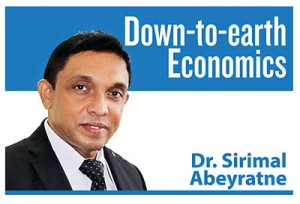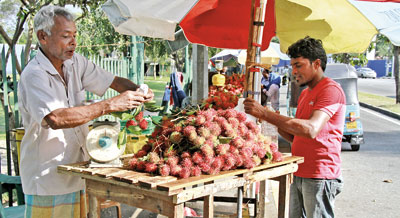Exchange rates: Surge in buying demand
View(s):Last week Sri Lanka’s exchange rate hit a record low with the US dollar being traded at over Rs. 155. As some reports were saying, it was for the “first time” in the Sri Lankan history! Obviously, when the rupee exchange rate rises all the time, every day can be a “first time”. I remember an old joke about how a politician claimed the credit for the rising rupee – dollar rate: “It is our government that gave the highest price for the dollar!”
Today, let’s understand in-depth who determines the exchange rate and what would be the consequences of its rise and fall. We can also try to comprehend what would be the ideal exchange rate scenario for a developing country like Sri Lanka and, in that context where are we now.
Buying and selling
In economics, it is always about buying and selling; buying is called demand and, selling is supply. Whenever there is a buying and selling issue (or demand and supply issue) in the market, the respective prices should respond; so is the foreign currency market. The only difference is that in other markets we are dealing with the price of goods and services. But in the foreign exchange market, we are dealing with the price of foreign currencies, which is called the exchange rate.
Whenever there is increased buying (demand), the prices tend to go up. Whenever there is increased selling (supply), the prices tend to go down. In other words, demand – supply imbalances would always cause prices to rise and fall. In addition, someone can also intervene and manipulate the market-determined prices at least temporarily.
In the same way, when there is increased demand for dollars (or any other foreign currency), the rupee price you pay for it goes up. This is called, a depreciation of the rupee. When you have to pay more rupees for a dollar, it implies that the value of the rupee depreciated or weakened against the dollar.
And when there is increased selling, the rupee price of a dollar should fall; this is called, an appreciation of the rupee. When you have to pay fewer rupees for a dollar, it implies that the value of the rupee has appreciated or strengthened against the dollar.
Foreign currency clients
Who are the buyers and sellers of foreign currency? People, companies, organizations, government agencies are all engaged in foreign business activities and transactions. When these clients have to spend in foreign currency, they buy dollars from the banks. This constitutes the demand side of the foreign currency market.
On the other hand, they are also engaged in earning or receiving foreign currency, while such foreign currency inflows enter the banks.
Thus banks as a foreign exchange intermediary institution buy foreign currency from those clients who supply it and, sell it to those clients who demand it. For instance, we know that importers demand foreign currency from banks to pay for their import consignments. Similarly, exporters supply foreign currency to the banks as they bring back the export proceeds to the country.
Foreign currency transactions are, however, not limited to exports and imports. Different clients in the foreign exchange market are involved in foreign currency transactions for various purposes, including direct investment, stock exchange, borrowings, and even making profits out of currency exchange itself.

When the rupee depreciates, even rambutan prices go up!
Power of public speculation
The reason for the unexpected increase in the rupee – dollar rate, as reported, was the sudden “uncertainty” caused by the local government election results. Given the uncertainty, importers panicked and exporters wanted to hold on. In other words, demand for dollars went up but the supply was contained; the rupee price of dollars shot up.
The cause is known as “speculation” in the foreign exchange market. Importers think that if they wait till tomorrow they would have to pay more rupees for the same dollar they want to buy; so they rush to the banks to buy it today itself. Consequently, the rupee – dollar rate will actually go up.
Exporters also speculate the same and act, moving in the opposite direction. They think that if they wait till tomorrow in order to bring export proceeds they can get more rupees for the same dollar; so they wait and see by delaying the supply of dollars. Consequently, it will also contribute to the rise of the rupee – dollar rate.
The problem of speculative attacks is that even if speculation is wrong, what was speculated would come to pass! This is because the market participants on the basis of their speculation begin to change their buying and selling decisions; in the foreign exchange market importers rush to buy dollars, while exporters defer to sell dollars.
Long-term trends, short-term fluxes
Short-term ups and downs of the exchange rate would eventually settle down, once the market gets adjusted and the speculation become weaker. We should, however, understand the long-term and short-term differences in exchange rate movement as well.
Sri Lanka’s rupee – dollar exchange rate throughout the past 40 years has been on a downward path. We began with Rs. 16 per $1 in November 1977; it has continued to depreciate exceeding Rs. 150 per $1 by 2017. This is not a typical case of a developing country, because it shows that we as a nation have been operating on a weak-footing in the foreign exchange market.
Let me quote another case to amplify the point: After leaving the fixed exchange rate regime in 1972, Japan’s yen – dollar exchange rate that was above ¥350 per $1, continued to appreciate for the next 40 years reaching its lowest in 2011 as ¥75 per $1. As part of the economic policy reforms under the Premier Shinzo Abe, Japanese yen was made to depreciate against the dollar which still remains around ¥110 per $1.
The above two cases show exactly the opposite movement of the exchange rates; why?
There is another dimension of the exchange rate management: In an aggressive export promotion drive, a government can choose to maintain an undervalued exchange rate even in the context of strong export growth and FDI inflows. Undervalued exchange rates encourage exports and discourages imports. Many East Asian countries maintained undervalued exchange rates. In this case, the Central Bank should purchase foreign currency in excess of market demand and, build up its foreign exchange reserves.
Given the strong export growth and FDI inflows, the Chinese yuan must have appreciated since the early 1980s. But China kept its yuan – dollar rate undervalued and, only after 2005 allowed it to appreciate against the dollar.
Stable and volatile currency inflows
Foreign exchange inflows are of different types: One type is the more stable transactions on exports and foreign direct investment (FDI). The second type is more volatile transactions which consist of stock market, bond market, and other portfolio investment; these types of currency flows can flood in and vanish easily and suddenly, compared to the former type.
Long-term trend in the exchange rate is determined more by export growth and FDI inflows than anything else. For this reason, the exchange rate signifies the productive strength and economic competitiveness of a nation on global scale. Therefore, without a strong export growth and FDI inflows, Sri Lanka’s exchange rate will not achieve long-term stability, but would rather reflect its greater vulnerability to volatile transactions and speculative attacks.
Government borrowings on both long-term and short-term basis can also bring about another dimension to the foreign exchange transactions; they are mostly accommodating transactions which would disguise the deep-rooted foreign exchange issue.
Stability and flexibility
The ideal scenario of a foreign exchange market is that the exchange rate should be “stable and flexible” – the two qualities seem contradictory, but not necessarily.
In the Sri Lankan context, they are contradictory, because if the government wants a stable exchange rate, the Central Bank has to intervene. Whenever there is excess demand for foreign currencies, the Central Bank should supply it out of its foreign exchange reserves. Then it is not flexible!
If the government wants to make the exchange rate flexible, then the Central Bank should leave the exchange rate to respond to the market imbalances. In such a case the exchange rate would shoot up, whenever there is excess demand caused by any shock such as the speculative attack. Then, it is not stable!
Where should we stand now? There is no short-term panacea; it is export growth and FDI inflows.
| Letter | |
| “Picking winners: Myths and realities” Reference to the above article published last week in the Business Times, the Professor of Economics at the Colombo University has just criticised the government’s plan without giving adequate statistics of such unsuccessful vs successful government-nurtured organisations, except for one or two examples. The professor is not suggesting any policy recommendations, instead, he is only criticising the Sri Lankan government’s plan. Some good examples can be seen from India which is fast developing through the Indian government’s policy of nurturing selected organisations. Choolanie Mayadunne |


